Different Types Of Mountains with Characteristics
What Are the Different Types of Mountains?
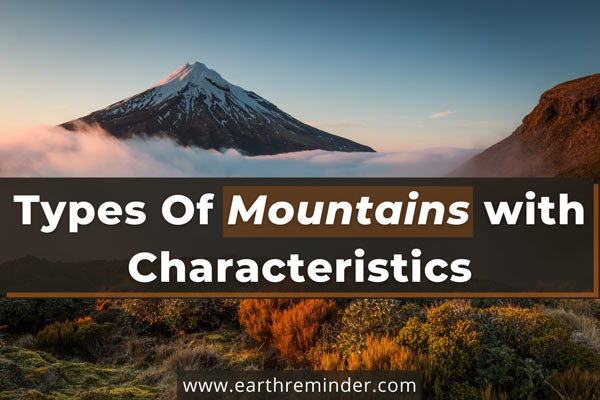
Earth’s landform is not the same everywhere; it varies from place to place. Moreover, it does not remain the same. Over time, it changes depending upon the geographical activities. Similarly, the mountains that we see today were not always there.
They formed over millions of years. Earth’s internal and external activities shape its surface and lead to the formation of mountains.
Want to understand the process of mountain formation? What are the different types of mountains, and how are they classified? Read along to learn in detail all the characteristics of mountains.
Table of Contents
What Are Mountains?
The snow-covered, high rising landscape with a sharp peak reaching the sky is generally called Mountain.
Here are some peculiar characteristics of mountains:
- By definition, any elevation of the earth surface with one or more peaks is called Mountain.
- The temperature on top of the mountain is usually low. Therefore, the peak of the mountain is covered with ice.
- The Peaks of the Mountain are arranged in succession, forming ridges and ranges.
- Depending upon the age of mountains, their peak could be steep or broad.
- Mountains are usually formed when two tectonic plates push each other. (More on that later)
- Mountains provide around 70% of the world’s freshwater.
What Are the Different Parts of The Mountain?
Mountains may seem to be a single landmass rising to the sky. However, there are different parts of the mountain;
- Valley: It’s the land space that lies between the two rising landmasses of the mountains.
- Foot: Foot of the mountain, also called the base of the mountain, is the broad structure from where the landmass begins to rise above. It’s the lowest part of the mountain.
- Slope or Skirt: The slanted part of the mountain that lies between the top and the foot of the mountain is called its slope.
- Top: The topmost part of the mountain, often steep and covered in snow, is called the top of the mountain.
What Are Mountain Ranges?
When peaks of mountains are arranged one after the other, they form a long chain of peaks, often called a range or mountain range.
Some of the mountain ranges on Earth are:
- Andes – in South America
- Rocky Mountains – in North America
- Himalayas – in Asia
- The Alps – In Europe
How Mountains Form?
Before you can understand the types of mountains, it’s essential to know how they are formed.
The process of mountain formation is called orogenesis.
- The surface of the Earth is made up of huge slabs called tectonic plates. These plates are not stationary; instead, they continuously move.
- When two different slabs or tectonic plates collide with each other, the land can sometimes be pushed upward, forming mountains.
- Many of the mountain ranges on Earth formed due to the collision of tectonic plates millions of years ago.
Types Of Mountains with Characteristics
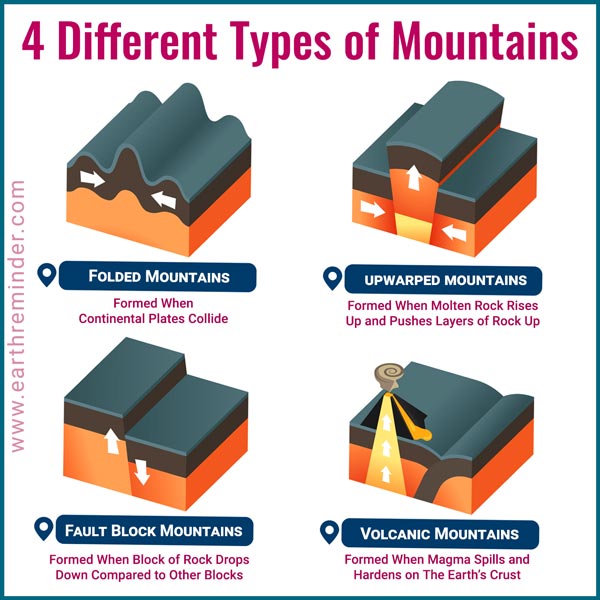
There are several parameters to classify mountains. It could depend on the age, altitude, and origin. But the origin is the most defining characteristic of a mountain and, therefore, the most used parameter to classify mountains. Here we classify mountains According to their origin.
Four Types of Mountains According to Their Origin
Mountains form due to the slow but constant movement of the Earth’s crust. Although the movement of tectonic plates is behind almost all mountain formations (except dome and volcanic), not all mountains are the same. Depending upon the internal and external activities of Earth’s crust, there are four types of mountains:
- Folded Mountains
- Fault Block Mountains
- Vault or Dome Mountains
- Volcanic Mountains
What Are Folded Mountains?
Folded Mountains are the most common type of mountain on Earth. Some of the highest rising mountains on our planets are folded mountains.
- Folded mountains are formed when two or more tectonic plates collide with each other.
- The process of folded mountain formation is called orogeny. It takes millions of years for the orogeny process to create folded mountains.
- The region where the plates collide is known as continental collision zones or convergent plate boundaries.
- The plates push each other with such a force that the rocks and the boundaries fold and wrap, forming mountains.
When folds are pushed downwards, they are called synclines. However, when the folds are pushed upwards, they are known as anticlines.
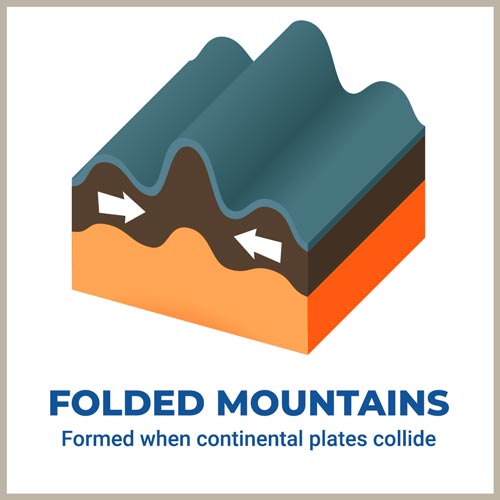
The folded mountains could continue rising as the tectonic plates keep pushing each other. The Himalayas, for example, are still rising.
Characteristics of Folded Mountains
- Most folded mountains on our planets are made up of sedimentary rocks.
- Sedimentary rocks are formed when sediments deposited in sea bed’s depression called geosynclines are compressed to form rocks.
- Folded mountains could rise high but remain narrow. They could span thousands of kilometers.
- Folded Mountains are the most common types of mountains found on Earth.
- Pushing plates forces rock to form folds. Therefore, folds are the most defining characteristic of these types of mountains.
Types of Folded Mountains
There are mainly two types of Folded mountains:
- Young Folded Mountains
- Old Folded Mountains
Young Folded Mountains: Young Folded mountains are those mountains that are around 10 to 20 million year old. They have a steep and sharp summit. The Himalayas are an example of a Young Folded Mountain.
Old Folded Mountains: Old folded mountains are those mountains that are more than 25 million years old. They have a broad summit due to the wear of Earth’s geological activities. The Urals are an example of an old, Folded Mountain.
Example of Folded Mountains
- The Himalayas in Asia
- The Alps in Europe
- The Urals in Russia
- The Rocky Mountains in North America
- The Andes in South America
What are Fault Block Mountains?
Another mountain that is the direct result of the movement of tectonic plates is Fault Block Mountains.
- Fault blocks mountains are formed when faults or fractures in Earth’s crust, pushes rocks upwards and downwards.
- In this case, the Earth’s crust does not fold; instead, it breaks or fractures. The resultant faults could move blocks of rocks upwards or downwards.
- When blocks of rocks are pushed upwards, they are called horsts. Similarly, when the rocks are pushed downwards, they are called graben.
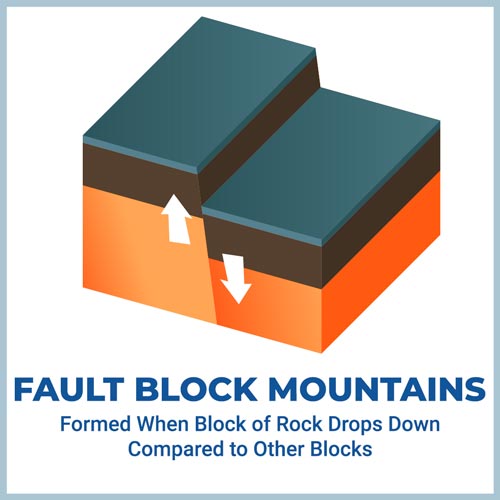
Characteristics of Fault Block Mountains
- Fault Blocks Mountains are formed due to faults in Earth’s crust where it breaks or separates.
- There is no folding of the rocks, like in the case of folded mountains. Instead, rock blocks are pushed upwards and towards creating summits and valleys.
- The movement of the Earth’s crust along the faults often cause an earthquake in the adjacent areas.
- One significant characteristic of Fault Block Mountains is their sloping rear and steep front.
Types of Block Mountains
There are two types of Block Mountains found on our planets;
- Lifted Block Mountains
- Tilted block mountains
Lifted Block Mountains: Block Mountains have two very steep slopes and a broad top with clear horst and garden terrains. The example includes the Vosges mountains in France.
Tilted Block Mountains: Tilted Block mountains are characterized by a gentle slope on one side and a steep slope on another side.
Examples of Fault Block Mountains
- The Harz Mountains in Germany
- The Sierra Nevada Mountains in North America
What are Vault or Dome Mountains?
Dome mountains do not involve the movement of tectonic plates. Instead, the movement of molten rocks or magma under the Earth’s surface results in the formation of Vault or Dome Mountains.
- Magma under the Earth makes its way towards the surface.
- Without breaking to the surface, it pushes the different layers upwards, resulting in an elevation or dome.
- After some time, the magma cools down and forms rocks. The resultant elevation is known as vault or dome.
- High rising domes are eroded by wind and water, forming several dome-shaped peaks called Dome Mountains.
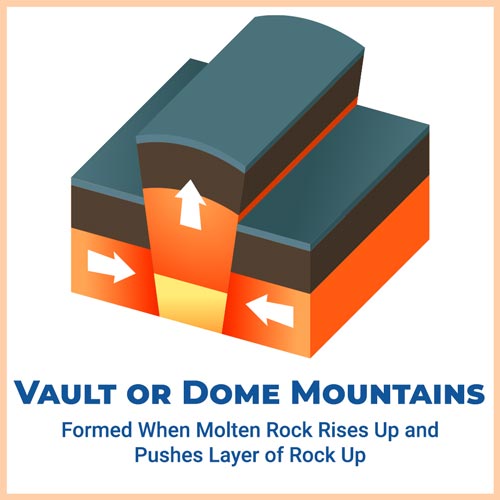
Characteristics Of Dome Mountains
- No tectonic movement is involved in the formation of the Dome Mountains.
- These mountains often have very steep slopes; however, they do not have sharp peaks, unlike other mountains.
- Erosion via air and water wears down the upper layers of Dome Mountain, revealing the cooled and solidified magma.
Example of Dome Mountains
- The Weald in southeast England
- The Black Hills of South Dakota
What are Volcanic Mountains?
A volcano is a vent in the Earth crust, through which magma rises and erupts to the surface. Volcanic activity also pushes the nearby regions upwards to form the volcanic mountain.
- Molten rocks move upward, pushing the surface upwards and then erupt, forming a volcano.
- Rocks and Lava pile up layer by layer and, when they cool down, form a cone-shaped structure called volcanic mountains.
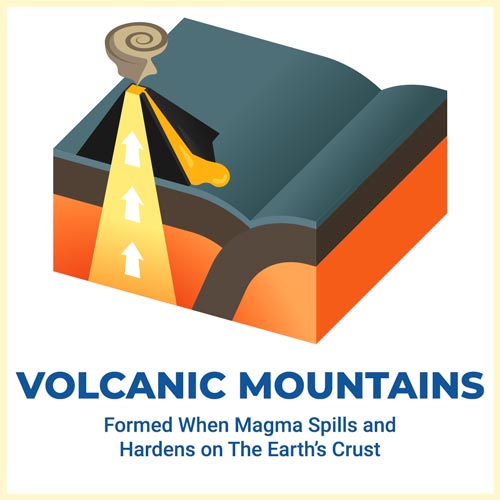
Characteristics of Volcanic Mountains
- Same as Dome mountains, Volcanic mountains are also the result of magma moving to the surface.
- Lava keeps gushing out of the vents and piles up in layers forming a rising cone-like structure.
- The most striking characteristic of a Volcanic Mountain is the crater. A crater is a circular depression formed when Lava forcefully erupts to the surface.
- Depending upon the volcanic activity, a volcanic mountain could be active or inactive.
Example of Volcanic Mountains
- Mount St. Helens in North America
- Mount Kea and Mount Loa in Hawaii
- Pico Teide in the Canary Islands
- Mount Pinatubo in the Philippines
Conclusion
It’s evident that different types of mountains adorn Earth’s surface. Some sharp, some narrow, some with the broad summit, and some ranging thousands of kilometers. But it’s Earth’s geological activity that gives rise to various kinds of mountains. The forces that pushed mountains to the skies are still active and are constantly at work, creating new mountain ranges and pushing the older ones further up the heights.